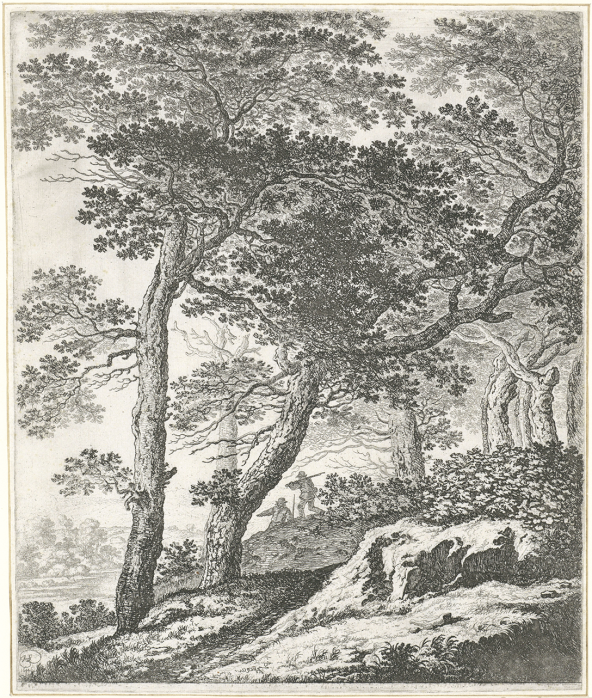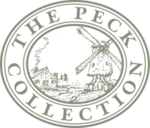Choose a background colour
Herman Saftleven, Dutch, 1609-1685
:
Woods near Doorn, with a Shepherd and His Flock, c. 1645-55
Black chalk with brush in brown and gray ink on paper.
15 3⁄4 × 11 11⁄16 in. (40 × 29.7 cm)
Recto, upper center, in pen and brown ink, by the artist, bij Doren (near Doorn); verso, lower center, in pencil (possibly nineteenth century), Coll. A…/de Hag.
- Chain Lines:
- Horizontal, 24 – 26 mm.
- Watermark:
- Foolscap with Five Bells. Similar to Schapelhouman & Schatborn 1998, 243, no. W101; and Beck 1972 – 91, vol. 1, 331, fig. 23.
- Provenance:
Antiquariaat H. Marcus, Amsterdam & Düsseldorf, 1955; Hans van Leeuwen, 1911 – 2010, Amerongen (Lugt 2799a, stamp on verso); his sale, Christie’s, Amsterdam, 24 November 1992, lot 175; Sheldon and Leena Peck, Boston (Lugt 3847); gift to the Ackland Art Museum, inv. no. 2017.1.77.
- Literature/Exhibitions:
Arnhem 1958, no. 91; Utrecht 1959 – 60, no. 53; Laren 1963, no. 98; Nijmegen 1965, no. 21; Leeuwarden 1966, no. 15; Bonn, Saarbrücken & Bochum 1968 – 69, no. 118; Rheydt 1971, no. 67; Bremen, Braunschweig & Stuttgart 1979 – 80, no. 115; Fribourg, Passau, Trier, Aachen & Nuremberg 1982 – 84, no. 85; Schulz 1982, no. 632; F. Robinson in Chapel Hill, Ithaca & Worcester 1999 – 2001, 94 – 95, no. 30.
- Ackland Catalogue:
- 2017.1.77
Herman Saftleven labeled this drawing as “near Doorn,”(bij Doren), a town east of his home in Utrecht. While the majority of the artist’s drawings feature broad and open landscape views, this study shows his skill at rendering aged trees and dense foliage in a wooded setting. To distinguish the foreground trees, Saftleven increased the intensity of black chalk marks along the trunks and limbs, but conflated the trees’ upper branches and leaves using a network of rapid strokes of chalk and wash. The contrast of brown and gray washes, applied selectively throughout the sheet, add volume and visual interest to the composition.
This sheet displays one of the most appealing sides of Herman Saftleven’s large body of drawings, the study of trees and dense foliage in a wooded interior, as opposed to the broader and more open landscapes that compose the majority of his oeuvre. Saftleven skillfully crafted a sense of spatial recession by varying the density of the chalk to set off the two foreground trees at the left with those behind them to the right. These forms merge above in a series of rapid strokes in chalk and wash to create an impressionistic tangle of branches and leaves. Saftleven’s application of two different tones of wash with the brush are so essential to the composition and lighting scheme that they appear to have been applied in tandem with the black chalk. This effect is seen especially well in the trunk of the foremost tree.
Saftleven labeled a number of his drawings like this one at the top center with the location, here given as “near Doorn” (bij Doren), which lies to the east of Saftleven’s hometown of Utrecht. These works obviously record sights from his various travels. From them it becomes apparent that he made a trip through Gelderland around 1644, resulting in a number of drawings that can be dated to the mid- to late 1640s, some having likely been worked up in his studio after his return.1
That may have been the case here as well, given the sheet’s high degree of finish. Since Doorn was not too far away from his hometown, some of these views possibly resulted from shorter trips taken at other times.2
Nevertheless, this drawing’s style accords well with other works from the same period, and the watermark also supports a date in the 1640s. It is also comparable to an etching by Saftleven dated 1644 Fig. 28.1.3

Herman Saftleven, Hilly Landscape with Hunters, 1644. Etching on paper, 272 × 227 mm. Amsterdam, Rijksmuseum, inv. no. rp-p-ob-15.055.
Rijksmuseum, Amsterdam
The etching has been linked to a group of drawings that he made in the woods near the village of Hoog Soeren near Apeldoorn during his travels farther afield through Gelderland. While some of Saftleven’s other tree study drawings resemble this one in composition and format, the presence of an identifying label closer to home is a good reminder, however, not to assume that the unlabeled drawings in this group were necessarily made in Gelderland.4
Among Saftleven’s other notable vertical-format tree studies from this period are drawings in the collections of John and Marine van Vlissingen, Clement C. Moore, and in the Hamburger Kunsthalle.5
The artist’s handling could be quite various in these works, ranging from sharply linear to more wash-driven, but the present work appears to have a searching, even experimental quality that he never quite repeated in his other tree studies.
End Notes
Schulz 1982, 73 – 74, 304 – 06, nos. 654 – 65.
Aside from the 1644 trip through Gelderland, it is also apparent that Saftleven took a longer trip down the Rhine River into Germany around 1651; see Schulz 1982, 74ff.
Bartsch, no. 27. For the related preparatory drawing in Munich, Staatliche Graphische Sammlung (inv. no. 1800), which is indented for transfer, see Wegner 1973, no. 896.
Peter Schatborn has already pointed out that one of the drawings in this group (Schulz 1982, no. 655, now in the Van Vlissingen Collection) could not have been taken from a view in Gelderland given the rocky cliffs in the background, though these might be entirely imaginary in construction rather than taken from a location farther afield; see Schapelhouman & Schatborn 1993, no. 39.
For the Van Vlissingen (ex-Klaver) drawing, see Schulz 1982, no. 665; Hans Verbeek in Amsterdam & Paris 2015 – 16 2015, no. 34; and Schapelhouman & Schatborn 1993, no. 39. For the Moore drawing, see Schulz 1982, no. 655; and New York 2012, no. 38. For the drawing in Hamburg, see Schulz 1982, no. 660; Stefes 2011, no. 915; and Stefes, Van Sloten & Van Oosterzee 2012, no. 100.
